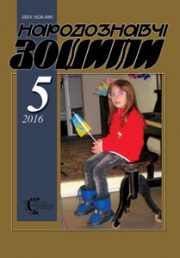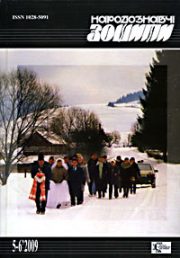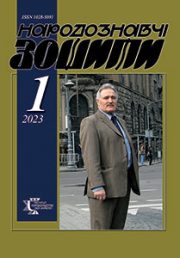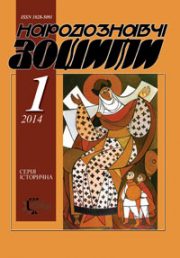The Ethnology Notebooks. 2022. № 2 (164), 337—348
UDK 394(477.86/.87):329.614]82-94-043.3:316.62
DOI https://doi.org/10.15407/nz2022.02.337
KOLOMYICHUK Oleksandr
- ORCID ID: https://orcid.org/0000-0003-2865-2396
- Ph. D. in History, research fellow,
- the M. Rylskyi Institute for Art Studies,
- Folkloristics and Ethnology
- of the Ukrainian National Academy of Sciences,
- 4, Hrushevskoho St., Kyiv, 01001, Ukraine,
- Contacts: e-mail: kolsasha7@gmail.com
Abstract. The change of socio-political accents in the recognition of forced deportations of 1944—1951 at the state level actualizes the chosen issue.
The narratives of resettlers from Western Boykivshchyna, who were deported during two infamous eviction actions — Operation Vistula in 1947 and «Action 1951», are the object and source base of this study.
The purpose of this article — to trace how the fact of participation in the nationalist underground of someone from family of resettlers influenced the future fate of themselves of resettlers based on the oral memoirs of this ones introduced into scientific circulation for the first time, also published collections of memoirs and available scientific literature.
The circumstances under which personalities experienced radical changes in their own lives, without actually being involved in the insurgent resistance through the prism of the narratives of resettlers from Western Boykivshchyna were determined.
Historical context and conditions in which the nationalist underground operated in the second half of the 1940s in the light of eyewitness accounts have been traced. Special attention is paid to the most dramatic parts of the biographical narratives of resettlers, where they appear as young children. According to the research by modern western psychologists, older people have a much greater ability to recall detailed stories from their childhood. That’s why childhood recollections from the personal lives of resettlers in the light of their narratives in detail have been traced. Similar episodes from the past lives of the respondents as a kind of their traumatic memory have been described. High cost of such tragedies in the personal life of narrators have been emphasized; their role in the struggle for a free Ukrainian state was marked.
In addition to general scientific principles, comparative, textual methods, field research methods were used. The introduction into scientific circulation valuable materials of oral history, recorded from direct witness of the events, is a novelty of this study.
Keywords: resettlers, Western Boykivshchyna, narrative, nationalist underground, insurgent resistance, trauma.
Received 14.04.2022
REFERENCES
- Yurystovs’kyj, I., Yurystovs’kyj, O., Slyvka, Yu., Lytvyn, M, Luts’kyj, O. (Eds.). (2002). Village Korostenko. Deportations: Western lands of Ukraine in the late 30’s — early 50’s. Documents, materials, memoirs: in three volumes (Vol. 3, pp. 34—37). Lviv: Institute of Ukrainian Studies named after I. Krypiakevych of the National Academy of Sciences of Ukraine [in Ukrainian].
- Tokarchyk, V., & Huk, B., Ivanyk, M. (Eds). (2007). U liudej vidpadalo tilo… Jaworzno: Memoirs of prisoners of the Polish concentration camp (Pp. 127—130). Lviv: Vydavnytstvo L’vivs’koi politekhniky [in Ukrainian].
- Scherbyk, M., Huk, B., Ivanyk, M. (Eds). (2007). Voda j voda — raz zvaly ii kavoiu, raz zupoiu. Jaworzno: Memoirs of prisoners of the Polish concentration camp (Pp. 127—130). Lviv: Vydavnytstvo L’vivs’koi politekhniky [in Ukrainian].
- Buchylo, M. (2006). To drive out, to scatter. «Karta»: historical quarterly journal, 49, 32—63 [in Polish].
- Pan’kiv, М. (2001). Wrong. According to accounts of Alexandra Bila-Karpa. Faith. Hope. Love (Pp. 340—345). Warsaw [in Ukrainian].
- Kryshtopa, O. (2019). Poland’s last Ukrainians. Brusturiv: Discursus Publishing House [in Ukrainian].
- Smolenski, P. (2017). Wormwood Syrup. Exiled in the Action «Wisla». Wolowiec: Zarne [in Polish].
- Kliashtorna, N. (2009). Action51. Book of Memory. Broshniv; Osada [in Ukrainian].
- Kliashtorna, N. (2006). Action51. The Last Witnesses. Vinnytsia: DKF [in Ukrainian].
- Petrechko, D. (2010). Lost Ukrainian Villages. Chorna. Broshniv; Osada: Talia [in Ukrainian].
- Kuzmenko, O. (2018). Dramatical existence of human in Ukrainian folklore: conceptual forms of expression (period of the First and Second World Wars). Lviv: The Ethnology Institute of National Academy of Sciences of Ukraine [in Ukrainian].
- Krukar, W., & Wolski, J. (Ed.). (2016). Military and Post-war Migrations of Boikos. In Wolski, J. Boykiwshchyna Yesterday, Today, Tomorrow (Pp. 17—63). Warsaw: Stanislav Leshchytski Institute of Geography and Spatial Organization Polish Academy of Sciences [in Polish].
- Syrnyk, J. (2018). Bieszczady Triangle. Thousand days and thousand nights of anarchy in Lesko poviat 1944—1947. Rzeszow: Libra PL Sp. z o.o. [in Polish].
- Brocki, M. (2003). Semioza of memory in ethnography. Polish Folk Art.Contexts, 3—4, 92—94 [in Polish].
- Kaniowska, K. (2003). Anthropology and the Problem of Memory. Polish Folk Art. Contexts, 3—4, 57—65 [in Polish].
- Soroka, Yu. (2013). Population of West-Ukrainian Lands: Ethnopolitical and Demographic Dimension, 1939—1950’s. Kyiv: Kyivs’kyj universytet [in Ukrainian].
- Assmann, J. (2008). Cultural Memory, Script. Recollection, and Political Identity in Early Civilizations. Warsaw: The University of Warsaw Press [in Polish].
- Kurpiel, A. (2014). Oral memories. Wroclaw Oral History Annual, 4, 21—45 [in Polish].
- Ratkowska-Widlarz, L. (2011). Narratives (witnesses testimonies) in a cultural anthropologist’s workshop. Memory and anthropology. Wroclaw Oral History Annual, 1, 35—56 [in Polish].
- Kachmar, M. (2021). Motive of аssistance in the paradigm of relations between Ukrainian insurgents and local population (according to folklore narratives from Ivano-Frankivsk region). The Ethnology notebooks, 1, 3—18 [in Ukrainian].
- Pavliv, Yu. (2018). «We Were Beaten, Slaughtered», «Those Were the Time»: on Collective Trauma and Narratives of Suffering on the Ukrainian Persons Deported from Poland in 1944—1951. Ukrainian Historical Collection (Issue 20, pp. 189—202). Retrieved from: http://resource.history.org.ua/publ/Uiz_2018_20_17 (Last accessed: 03.01.2021) [in Ukrainian].
- Viatrovych, V. (Ed.). (2011). Polish-Ukrainian relations in 1942—1947 in documents of the Organization of Ukrainian Nationalists and the Ukrainian Insurgent Army: in two vol. (Vol. 2: War after war. 1945—1947). Lviv: Centre for Research of Liberation Movement [in Ukrainian].
- Viniarchyk-Kossakovs’ka, M, Hajovnichek, Z., & Kulakovs’kyj, P. (Eds.). (2000). Poland and Ukraine in the 1930s and 1940s. Unknown documents from the Archives of the Secret Services (Vol. 2: Resettlement of Poles and Ukrainians 1944—1946). Warsaw; Kyiv [in Ukrainian].
- Onys’kiv, M. Traces on maps. Where to look for the memory of the German colonists of Prykarpattia. Retrieved from: https://kufer.media/lyudy/slidy-na-mapah-de-shukaty-pam-yat-pro-nimetskyh-kolonistiv-prykarpattya/?fbclid=IwAR3cbugJ6HelTCgLSat_fHqGu3_-DUmSDEDZKCSGViryh5y2JocASfWntLI (Last accessed: 29.09.2021) [in Ukrainian].
- Pan’kiv, M. (2017). OUN-UPA shelters, hideouts and bunkers. Documents.Recollections. Short biographies. To the 75th anniversary of the Ukrainian Insurgent Army. Ivano-Frankivsk: Misto NV [in Ukrainian].







